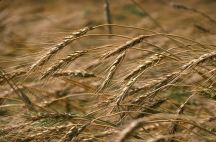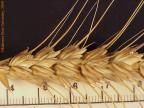|
|
 |
| Welcome | Getting Started | Resources | Site Map |
Week 2
High-Energy Feedstuffs |
Instructions for listening to audio clips
- Download the QuickTime Player to listen to the audio files.
- Read the QuickTime Instructions for installation help.
- Download the RealPlayer to listen to the audio files
- Instructions are on the RealPlayer download page
Wheat
Time: 3.00
Follow along with the audio...
- Primarily grown for human consumption
- Small portion fed to animals
- Generally, not affordable feedstuff
- Grown in range of regions
- Figure 4.16 – Wheat plant in the field
- Estimated average yield – 40.2 bushels per acre
- Figure 4.17 – Wheat grain on the head
- Figure 4.18 – Wheat grain
- Nutritional value
- Table 4.6 – Average nutrient composition of wheat
- Energy source
- Slightly lower than corn
- Protein source
- Content
- Higher than corn
- Similar to barley and oats
- Amino acid profile
- Better than corn
- Ranked below oats and barley
- Remains deficient in lysine, threonine, and methionine
- Gluten proteins
- Aids in pelleting
- Lipid content
- Relatively low
- Classification
- Kernel texture; hard or soft
- Hard – higher protein, better amino acid profile, and higher gluten
- Kernel color; white, red, or amber
- Planting/growing season; winter or spring
- Feeding livestock
- Deleterious factors – ergot and mycotoxins
- Palatable
- Rapid rate of starch digestion
- Processed
- Poultry
- Substituted for corn
- Ruminants
- Added in limited amounts; combination with other grains
- Swine
- Fed to young and finishing animals



Nutrient |
Average Composition
– (HW; SW), % |
|---|---|
Crude protein |
14.2; 11.7 |
Ether extract |
1.7; 1.8 |
Crude fiber |
2.3; 2.1 |
Ash |
2.0; 1.8 |
NFE |
79.8; 82.6 |
Starch |
63.4; 67.2 |
| |
| Welcome | Getting Started | Resources | SiteMap |